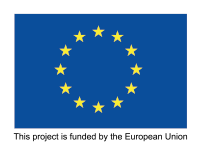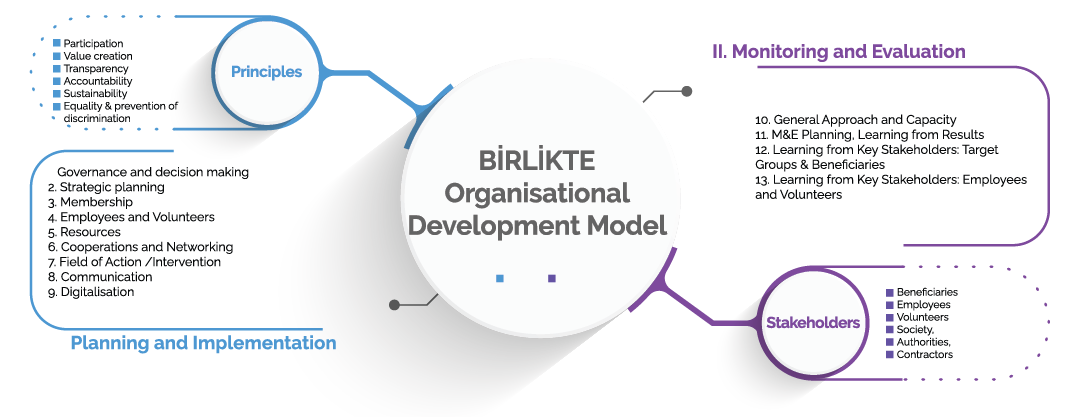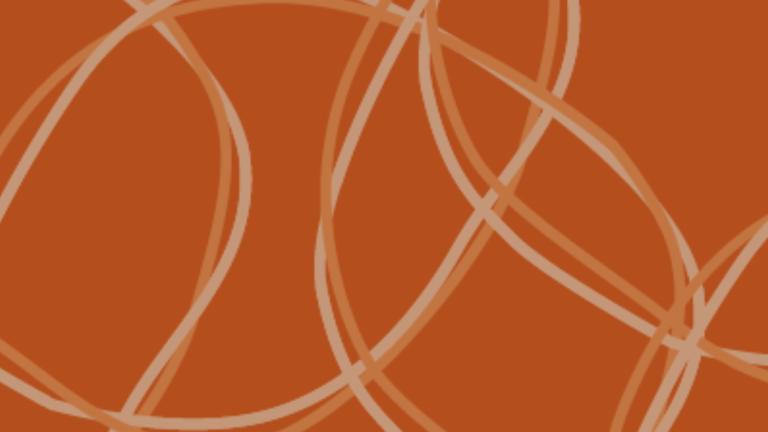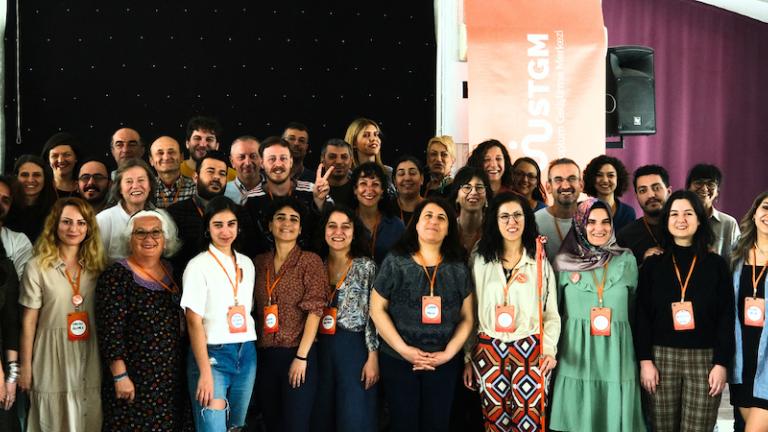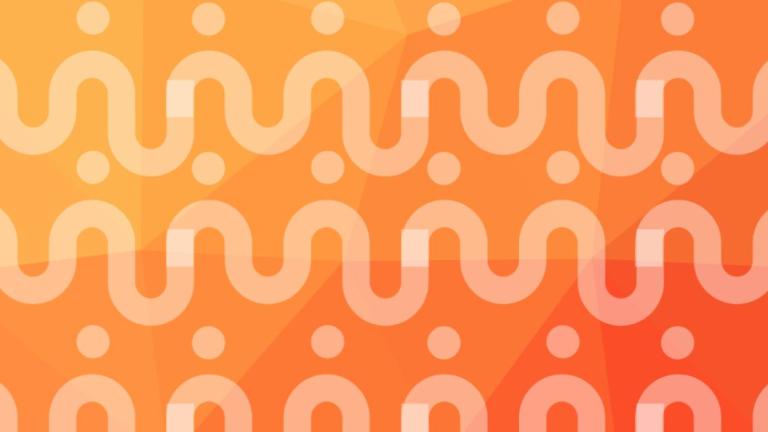
An Institutional Development Model for CSOs "BİRLİKTE"
We have recently updated the "Institutional Development Model" we developed and implemented for the BİRLİKTE Support Program, which we designed based on our long experience in the civic space and implemented its first period between 2017-2020, and started to implement it with the participants of the new period.
We have written about why and with which needs the institutional development model we developed in the first period of this long-standing journey was updated in the new implementation period and our preparation process with the aim of providing ideas and inspiration for the subjects working in this field.
Why did we need an update? How did we make the update? What did we take into account?
In terms of management models in general, designing a model is a difficult and long process. The reasons for this difficulty can be briefly attributed to the following issues; the first of these is that the party that will design the model should know the audience that will use the model well, know its culture and management needs in detail. The second issue is the need for a thorough understanding of the field and sector where the model will be implemented.
If we want to expand on this issue, if the model is to be used in the public sector, it should be specific to this area, if it is to be used in the private sector, it should be specific to this sector, and if it is to be used in the field of civil society, the model should take into account the sensitivities of this sector. Finally, even if the target audience and sector are well known, the team preparing the model should have a good command of management. This way, the most suitable and development-supporting model framework is outlined for the target audience and sector.
In 2018, while preparing the Institutional Development Model within the scope of the BİRLİKTE Program, we paid particular attention to these three issues. We have repeatedly addressed the culture and needs of rights-based civil society organizations that we have been serving for years in the design of the model. In addition, we also took into account the difficulties and problems experienced by the civil society field in Turkey and the existing prejudices.
For example, we prepared a section in the model based on the difficulty of developing resources outside the project in the field of civil society. Again, we prepared a governance section based on the fact that participation makes a difference for a strong civil society organization. In the development of this model, we brought together experts who know the subject of governance very well with experts who know the organizations and the sector well. We carried out the first pilot study with the participation of the entire mentor team in the first term of BİRLİKTE. We standardized the model in the structure you can see below.

A model that incorporates the years of experience of STGM and many experts in the field
After standardization, together with five mentors, we carried out field studies to implement the model in 42 organizations. We used this institutional development model for 2.5 years. With the feedback from mentors and organizations, we reviewed the suitability of the model in terms of organizations, the entire civic space and the management framework. We closed the program in 2020 with the archiving of all these learnings.
The continuation of the BİRLİKTE Program in 2022 brought about two advantages together. The opportunity to transfer the learnings previously gained for organizations and civil society to the field, and the opportunity to further improve an already well-developed, tested, and proven management model that had been meticulously crafted within the BİRLİKTE program before. Thus, we started to work on carefully reflecting the changing needs of the field, which had already been recognized in the BİRLİKTE program, in this new model. We carried out the work with the participation of the whole team and with the support of external experts on certain technical issues in a period of about six months. This is how we ensured that dozens of people and years of experience were transferred to the model. We reviewed the entire model and redesigned it by taking into account the needs of civil society and organizations, especially in the areas of membership, staff and volunteers, digitalization, monitoring and evaluation.
Members, one of the important stakeholders that make up the base of organizations, and the systems that need to be designed for them are discussed in the membership section. We have further developed this section to ensure that civil society employees have access to their rights within the organization and to ensure their sustainability through well-developed human resources policies. We have added a digitalization section in line with the learning from developments in the world and the needs of organizations. We have redesigned monitoring, evaluation and learning with a system logic, with the question of how it can be handled in a holistic way.
We integrated gender equality perspective into the model
Another important innovation in the updating process was the integration of a gender equality perspective into the model. In line with the objectives and approach of BİRLİKTE Program, we have treated gender equality not as an isolated topic in the model, but as a fundamental issue that cuts across all areas. Thus, we emphasized that gender equality is a fundamental issue that needs to be addressed with subtlety and depth in all areas from governance to membership, from workspace to communication.
What are the advantages and challenges of the model?
Management is a multifaceted issue with the stakeholders it addresses, has a certain philosophy with the values it is based on, and deals with many areas systematically. This is why it is likened to art when it is done well; doing it with both good systems and a good philosophical depth makes management an art. It is not possible to meet these multi-stakeholder, systemic and philosophical features of management with a checklist. A model that addresses all these holistically is needed.
When such a model is used, organizations can move towards a more mature organizational culture with a certain philosophical depth. When the philosophical depth is not well understood, there may be problems in the implementation of the established systems. As in the chicken and egg relationship, without systems, the philosophy cannot find the space to come to life. As a result, the impact and change that should be created for stakeholders do not emerge.
For example, if "employee participation" is a philosophy, creating participation mechanisms (such as giving everyone equal say in meetings, creating environments where employees are consulted on relevant decisions, creating environments where suggestions and complaints are received) is the system dimension of the work. In an organization where the philosophy and mechanisms of employee participation are not in place, many stakeholders, such as employees, target groups, members, volunteers, etc., are negatively affected. Therefore, models make an important contribution to better management and sustainability of organizations.
6 principles for the change process
It is important for organizations, which are the main actors of the civic space, to work with principles and values. For this very reason, the model we have created in BİRLİKTE takes reference from some basic principles in order to radically realize the desired change process. The model is based on 6 principles: value creation, participation, sustainability, equality & prevention of discrimination, transparency and accountability. We apply these principles and values by mainstreaming them throughout the model.
There are also aspects of the models that challenge the implementing parties. The first of these is the insufficient prioritization of the philosophy of the model, which refers to the principles and values on which the model is based, or the expectation for the philosophical depth to be established all at once. It's not possible for an organization struggling with implementing participation to suddenly have participation firmly in place. The establishment of the philosophy, in other words, a cultural change, requires a consistent and patient effort spanning years.
Another challenge is working with systems. Organizing practices such as volunteer work, activism, being fast and reflexive can make it difficult for organizations that grow over time to create systems that fit their needs. As a result, for some organizations, arbitrary and daily work without a system can be confused with flexible and creative work.
For this reason, organizations may not want to establish a system that creates benefits in many respects. The organization is deprived of many of the benefits of systems. Such as the fact that work is not dependent on individuals, the existence of institutional realistic methods, the formation of institutional memory, the reduced likelihood of making mistakes, employee and volunteer motivation, focus on the needs of stakeholders, transparency and accountability. This list can be extended.
How is the self-assessment structure in the model an experience for organizations?
We define self-assessment as the self-evaluation of an organization according to a model.
According to the BİRLİKTE model, organizations conducted their first self-assessment between March and May 2023. They can best describe what the experience was like, but we can also briefly express our observations.
Knowing yourself is one of the most difficult issues in life. During the self-assessment process, the most important step taken by the organizations participating in BİRLİKTE was to look back at themselves and know themselves. In the hustle and bustle of daily life, organizations that had not had the opportunity to stop and ask what are we doing, how are we doing it, what results have we achieved, looked at themselves from this perspective and confronted themselves on many managerial issues. This confrontation took two forms. Sometimes it was "the happiness that we are not so bad"; and sometimes it was "the realization that we are not so perfect".
The confrontation that there is something better can also bring a denial in itself. "No, we were good, how could we be in this situation"; is the first stage. The second stage is the acceptance of "maybe, we may not be that perfect" and finally the dynamism of "there is no end to the good, we must change and continuously improve for our stakeholders";. In order to achieve these phases, a self-assessment is conducted at the beginning of each year to analyze the current situation, that is, to know oneself, followed by annual improvement plans and the implementation of prioritized improvements. The aim is to make these efforts as long as the organization exists and to make them sustainable. In other words, to prolong its lifespan and have a high impact.
How does learning from the process take place?
We can say that organizations learn the following from this process:
- Look at themselves objectively
- Managing with a model
- Making improvements every year and in the right areas
- Planning and working with a plan
- Systematic work
- Institutionalization
- To look at the equivalents of principles in institutionalization and management processes,
- Acting with a gender mainstreaming perspective in all processes,
- Listening to and even hearing beyond stakeholders
- Learning from the other's systems
What are we learning as BİRLİKTE?
- What are the practices and requirements of being a learning organization while providing institutional grants?
- What are the processes we need to improve in the program in terms of mainstreaming and sustainability?
- How can we ensure our own transformation in the principles proposed by the model?
- What are the needs of organizations in Turkey?
- What is their culture?
- In which areas are they strong?
- In which areas do they have potential for improvement?
- Where are the resistances focused?
- Where are the enthusiasms concentrated?
- How can we use what we learned while implementing the program to improve it?
- How can we contribute to the civic space as a whole with what we have learned in the program?
What is this journey like?
This journey is like "water dripping on stone" It is a journey that requires patience and years, but in the end even the stone can be pierced, creating incredible changes. Therefore, the journey itself is important, but it is also important to learn how to remain a passenger and attribute value to it. BİRLİKTE is actually a deep and long journey with organizations, and we are accompanying the first two years of this long journey, which is why it is valuable.
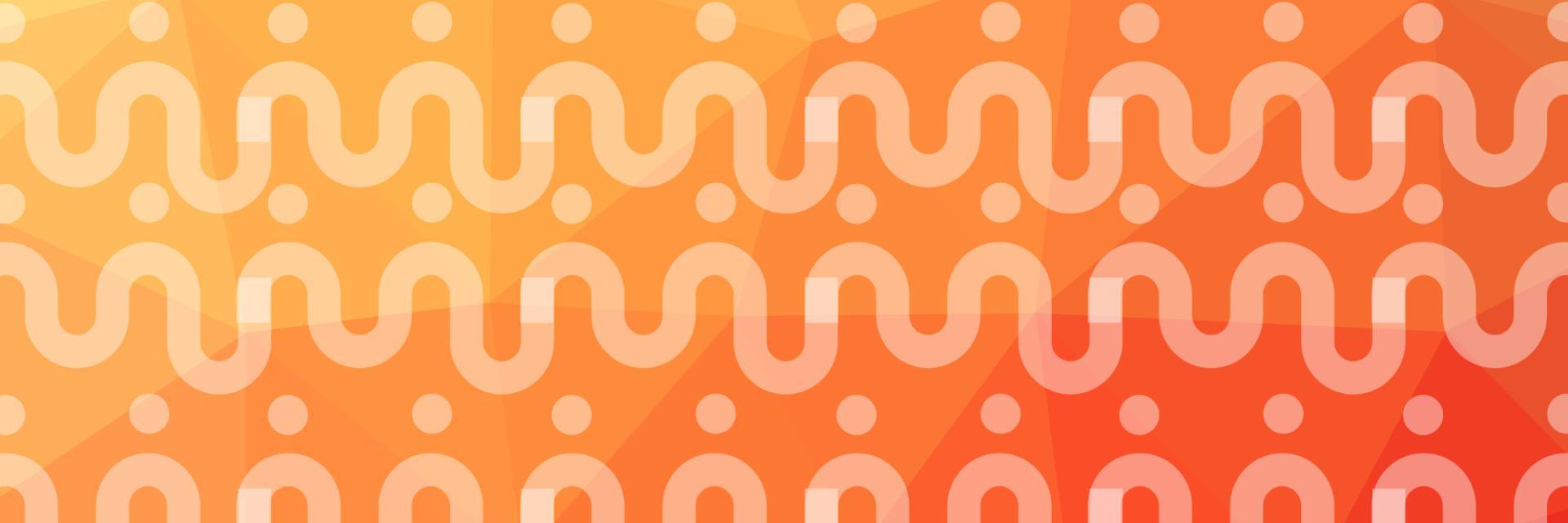
Subscribe to STGM Youtube Channel!
On the STGM YouTube Channel, you can find various tutorials, presentations and current discussions on civil society. Check out our channel now and subscribe.
